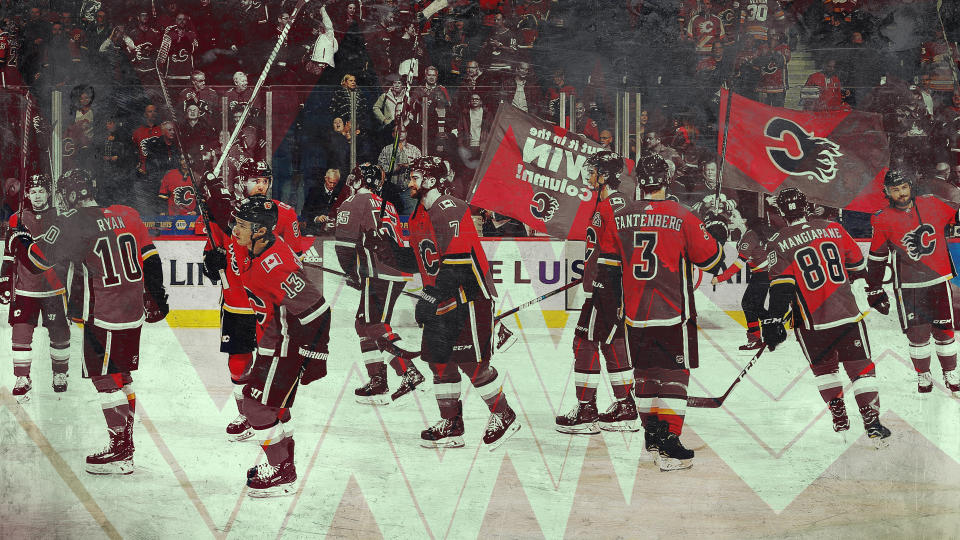How the Calgary Flames turned into legit Stanley Cup contenders
The sentiment that your best players need to be your best players is certainly well-travelled and overused, but that’s all the Calgary Flames needed to turn from playoff no-shows into legitimate Stanley Cup contenders in less than 12 months.
Their stars have played like stars.
A year after finishing fifth in the Pacific and well outside the Western Conference playoff picture, Calgary clinched a postseason berth last Sunday and finds itself in the mix for its first regular season division title since 2005-06 after another big W against the Blue Jackets on Tuesday.
This is by far the best Flames squad to hit the ice since the mid-2000s and maybe the best top-to-bottom squad Calgary has boasted since the franchise won it all nearly 30 years ago.

Cowtown is getting excited for another potentially magical spring, and it should be. Here’s why:
Absurd Top Unit
Honestly you don’t have to look much further than the three dudes occupying Calgary’s No. 1 unit.
Playing at a 100-point, 40-goal pace for the first time in his career, 25-year-old Johnny Gaudreau has rounded into a legit Top 5 NHL forward — but he isn’t the only one driving arguably the best top line in hockey. Centre Sean Monahan is boasting his best-ever offensive campaign while sitting third in the NHL in slot shots (Gaudreau sits fourth in completed slot passes), and Elias Lindholm found unmatched chemistry with his new linemates almost immediately after being acquired last offseason from the Carolina Hurricanes. He’s having his best NHL campaign, too.
Each piece from the team’s first line having concurrent career years has lifted the trio among the elite, and when you compare it to some of the other lights-out top lines around the game, you can make the case they have been the NHL’s best in all situations this season:
(Stats via Natural Stat Trick, as of March 20)
Gaudreau-Monahan-Lindholm (Flames) — 62.2% possession / 68.9% goal share (+51)
Landeskog-MacKinnon-Rantanen (Avalanche) — 61.9% possession / 70.3% goal share (+59)
Marchand-Bergeron-Pastrnak (Bruins) — 64.6% possession / 67.5% goal share (+28)
Laine-Scheifele-Wheeler (Jets) — 70.3% possession / 69.6% goal share (+31)
Hyman-Tavares-Marner (Maple Leafs) — 52.7% possession / 62.3% goal share (+21)
Marchessault-Karlsson-Smith (Golden Knights) — 59.7% possession / 58.1% goal share (+14)
San Jose and obviously Tampa also have potent offences, and they’ve been able to obtain the production they have with, for the most part, a mish-mash of different combinations up front. Sidney Crosby and Jake Guentzel and whoever head coach Mike Sullivan air-drops onto their wing have been ridiculous this season with the Penguins. As has Ovechkin alongside whichever healthy/non-suspended bodies get to play with him on a given night.
Take into account the numbers, familiarity the trio has with one another — playing more total minutes together than any of the aforementioned lines — and their consistency, it’s hard to argue that any three-man unit has been more valuable to their team’s turnaround than the Gaudreau-Monahan-Lindholm one.
And it doesn’t hurt to have an emerging superstar and first-line talent anchoring your second unit either.
Matthew Tkachuk
After posting 48 and 49 points in his first and second NHL seasons, respectively, Tkachuk floored it through his third campaign, bagging 73 points in 72 contests through mid-March. Mikael Backlund and Michael Frolik — who missed a solid chunk of games due to injury — have complimented Tkachuk and the Flames’ No. 2 unit nicely, but the 21-year-old has been the force behind Calgary’s secondary scoring since he stepped on the ice in October.
Tkachuk’s accelerated emergence into a top-line caliber player has been a godsend for the Flames. He’s on pace to almost match his goal total from the previous two seasons combined, putting up 32 tallies in 72 contests (0.44 goals per game) compared to the 37 he put up in 144 games (0.26 GPG) over his first two NHL campaigns. His shooting percentage has also jumped steadily and consistently from 9.2 to 12.8 to 17.2 percent year over year over year.
On top of wreaking havoc in the low-to-mid slot, along the boards and below the goal line while opening up the ice for his teammates and being an absolute reptile to play against, Tkachuk is taking advantage of that extra space with an increased ability to finish.
The Flames have put 8.1 inner slot shots on the net per night so far — third most in the NHL — and No. 19 is a big reason for the teams new-found prowess in high-danger scoring areas.
The (Deserving) Norris Trophy Winner
Mark Giordano, ladies and gentlemen.
What more can be said about the Flames captain, who is having a career season much like many of those already mentioned — except he’s doing it at 35. When he hit the 60-point plateau at the end of February, Gio became just the fifth defenceman in NHL history to reach that mark from the 35-plus club.
To say the production Giordano has put up this season was unexpected is the epitome of an understatement. He appeared to be on the decline after posting 38- and 39-point campaigns following a 56-point season in 2015-16. No one ever thinks to themselves “oh I bet our 35-year-old blueliner is going to have a career year after dropping off steadily the last couple of seasons,” but here we are.
Along with putting up the second-highest goal total of his career, Gio is set to smash his previous high for assists in a campaign and has seen a drastic increase in first assists in particular. The Flames captain has 22 primary helpers in all situations this season with just under ten games left — already four more than he collected the last two seasons combined, and five more than his career high.
The fancy-boy possession numbers are there, too. Giordano’s 59.9 percent Corsi is more than three points better than his career average and his 60.6 percent goal share is by far the best mark of his career.
Look ahead
Sprinkle in the higher tempo, offensively-driven system implemented by Flames first-year head coach Bill Peters, and a solid run by then-backup goaltender David Rittich which prevented the team from falling down a black hole when Mike Smith forgot how to stop pucks for a good two months earlier this season, and you have a recipe for high hopes and expectations.
They’ll need the saves and the adjustments behind the bench. They’l need their top unit, their secondary scoring, and their high-powered captain all in peak form — and of course they have to stay healthy.
A lot has to go right, but the Flames have put themselves in the conversation with their play while boasting a brand of hockey that can pose a matchup nightmare for many of the other contenders in the West.
It could be a very good spring in Southern Alberta.
More NHL coverage from Yahoo Sports



